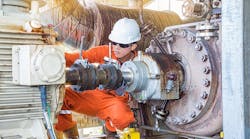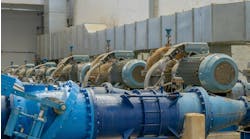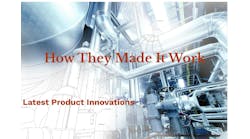A lot of widely used process equipment, such as pumps, compressors and mixers, rely on rotation of an element (impeller, blade, etc.) attached to a rotor. In a perfectly balanced machine, all rotors or rotating parts turn true on their centerline and all forces are equal. However, imperfections always exist and lead to some unbalance, which can cause vibration. Other effects such as misalignment, forces from working fluids, etc., also may create vibration.
The combination of all applied forces (including those from unbalance, working media, misalignment, etc.) and the stiffness and damping of the rotor-support system (including bearings and bearing pedestals) determine the vibration of a piece of equipment. Rotor-support stiffness is important because forces from different sources (unbalance, etc.) can deflect rotating elements from their true centerline; the stiffness resists the deflection.
Keeping all dynamic forces under control and practically in balance requires a clear understanding of the mechanical movement of the machinery and its components, as well as all involved forces. These are the foundations for vibration analysis and rotor-dynamics.
Here, we’ll look at vibration and its effects, focusing on practical pointers and useful guidelines related to vibration, rotor-dynamics, condition monitoring and operation of equipment. Most points apply to a wide variety of rotating machines and equipment.
Common Culprits
Factors that regularly contribute to vibration include unbalance; part loads, deviations and turbulence; and misalignment
Unbalance. Mechanical unbalance is the condition where more mass is on one side of a rotor’s centerline than on the other. While mechanical unbalance generates a unique vibration profile, it’s not the only form of unbalance that affects rotating elements. In many cases, rotor unbalance results from an unbalance between centripetal forces generated by the rotation. A rotor assembly might not rotate on its true centerline. This offset rotation creates an unbalance and a measurable level of vibration. Rotor vibration also can stem from an unbalance between the forces on the rotor assembly.
Part-load, deviations and turbulence. Working outside the optimum operating range may lead to higher vibration. Deviations from a machine’s specified operating envelope can directly affect the vibration profile. For example, the vibration level of a centrifugal compressor typically is low when operating at around 100% load with laminar gas flow through the compressor. However, running at decreased load can radically change vibration level. Operation at 60% load can result in a vibration increase of as much as 350% with no change in the mechanical condition of the compressor. In addition, a radical change in vibration level can come from turbulent flow in either the inlet or discharge piping. Turbulent or unbalanced media flow (aerodynamic turbulence, hydraulic instability, etc.) doesn’t usually have the same quadratic impacts on the vibration profile as that of load change but does increase the overall vibration energy.
The dynamic profile generated by unbalanced fluid flow usually is visible at the vane or blade-pass frequency of the rotating element. In addition, the profile shows a marked increase in the random noise generated by the flow of gas or liquid through the machinery.
Misalignment. If a driver connects to driven equipment by any form of coupling, there’s a risk of parallel and angular misalignment. This will cause vibration at both 1× and 2× rotational speed in both radial and axial directions. The force generated by the misalignment can deform sensitive parts and components such as the bearing housing, seal cartridge, etc., in the driver or driven equipment. A distorted bearing housing can result in bearings that are out of line. For machines with rolling-element bearings, the additional loads and forces can reduce bearing life to 25% or 20% (or even less) of the original expected life. Many cases of rolling-element bearing failures have been traced back to the misalignment.
Frequency Of Vibration
A vibration reading of a typical machine usually is complicated and contains many frequencies. It often is very challenging to relate these records or measurements to operating parameters and possible developing problems.
Many unique frequencies contained in the vibration signature of a machinery train can be directly attributed to a corresponding mechanical motion within the machinery. For example, the constant end play or axial movement of the rotating element in a typical machinery train generates an elevated amplitude at the fundamental (l×), second harmonic (2×) and third harmonic (3×) of the shaft’s true running speed. Forces resulting from gas or liquid movement also generate unique frequency components within the machinery’s signature. In relatively stable or laminar-flow applications, the movement of fluid through the machinery slightly increases the amplitude at the vane or blade-pass frequency. In more severe, turbulent-flow applications, the flow generates a broadband, random profile directly attributable to the movement of fluid through the machinery. It is sometimes a kind of white noise profile.
Other forces, such as the side-load, also generate unique frequencies or modify existing component frequencies. For example, the side-load on the shaft of a machine using rolling-element bearings can generate a unique frequency to identify the problem. This increase in side-load changes the load zone in the machine’s bearings, resulting in a marked rise in the amplitude at the outer-race rotational frequency of the bearing(s). Applied force or induced loads also can displace the shafts in a machinery train. As a result, the shaft will rotate off-center, which dramatically increases the amplitude at the fundamental (1×) frequency of the machine.
Another example is 0.5× frequency (referred to as half frequency) measured in some equipment with sleeve oil-film bearings. An oil-film bearing that has too much radial clearance or too small a radial load may become unstable. This results in the shaft orbiting in the bearing at just under 50% of the shaft speed. Theoretically, the basic problem is that insufficient damping exists to dissipate the vibration energy. An effective practical solution to avoid such 0.5× frequency problems is to use modern bearings such as tilting-pad ones.
Reciprocating And Linear-Motion Equipment
Vibration profiles generated by most reciprocating or linear-motion machines reflect a combination of rotating and linear-motion forces. However, the intervals or frequencies generated by these machines aren’t always associated with one complete revolution of a shaft. For instance, in a two-cycle reciprocating engine, the pistons complete one cycle each time the crankshaft revolves 360°. In a four-cycle engine, the crank should complete two complete revolutions, or 720°, to complete a cycle of all pistons. Because of the unique motion of reciprocating and linear-motion machines, they generate a level of unbalanced forces substantially higher than those produced by ordinary rotating equipment. As an example, a reciprocating compressor drives each of its pistons from bottom-center to top-center and returns to bottom-center in each complete operation of the cylinder. The mechanical forces generated by the reversal of direction at both top-center and bottom-center result in a sharp increase in the vibration energy of the machine. An instantaneous spike in the vibration profile repeats each time the piston reverses direction. Linear-motion machines generate vibration profiles similar to those of reciprocating machines. The major difference is the impact that occurs at the change of direction with reciprocating equipment. Typically, linear-motion-only machines don’t reverse direction during each cycle of operation and, as a result, don’t generate the spike of energy associated with direction reversal.
Defects, Damaged Components And Bent Shafts
Damage due to careless installation or assembly of parts and components has been the root cause of many failures or incidents. Installing a machine component with an undersized bore can damage sensitive parts such as bearings, especially if the installation tool is a hammer. The shock loads can pit rolling-element bearings or even crack a race or rolling element. Many cases exist of rolling-element-bearing installation using a punch and hammer rather than an appropriate method (such as a sleeve) that resulted in a bearing race that’s distorted or not square on the shaft.
Manufacturing defects and errors also too often lead to machinery failure. For instance, shaft problems can result from machining errors. It’s not uncommon for fork-lift trucks to get off course and cause fatal impact damage to equipment.
Tolerances and small irregularities may create some additional forces that affect machinery. For example, consider a fan with several equally spaced and identically shaped blades. In practice, each blade differs slightly, which results in one section of the fan producing more thrust than another. A fan, compressor or pump that is mounted in an irregular housing also will have unbalanced thrust or pressure.
A shaft that is straight at room temperature may bend when running at full load (heated or cooled), especially if the heating/cooling effect is uneven. Excessive load on the shaft can bend it. In addition, this can cause rapid failure of rolling-element bearings.
An eccentrically mounted rotor (of a pump, compressor, etc.) may have variations in pressure causing vibration that looks similar to unbalance. These effects generally are termed aerodynamic or hydraulic unbalance.
Machinery that’s not bolted rigidly to its foundation will have excessive vibration. The foundation controls the energy absorption; lack of a good connection to the foundation can lead to very high amplitudes of vibration. Too often, the vibration also shows itself at 2× or 3×. Frequently, it relates to a resonance of part of the system and occurs at other frequencies. The problem may arise from an irregular mounting surface or the use of a number of thin shims under a motor foot rather than a single piece of the correct thickness.
How To Reduce Vibration
Many different methods can reduce the vibration generated by a machinery package. Firstly, check if better balancing, alignment or operation can lower the vibration to the intended low levels. However, those steps alone won’t cut vibration enough for some equipment. In such cases, evaluate other methods such as isolators, vibration absorbers, etc., and incorporate a suitable option. Generally, any change in the mass, mass distribution, stiffness or stiffness distribution can change the vibration; so, a set of intelligent modifications of these (mass, stiffness or their distribution) can reduce the vibration. Traditional systems of base isolation such as springs or viscoelastic materials often can mitigate vibrations. However, these options often aren’t feasible or convenient for rotating equipment supported on complex structures (such as plate structures, structures fabricated of thin-walled profiles, etc.). In some cases, changes in the support structure or the operating conditions produced unexpected high levels of vibrations. An attractive alternative is to change the mass distribution, for instance, by incorporating masses (e.g., equal to 3, 5 or 10% of the total mass of the vibrating machinery) into the supporting structure. Obviously, addition of large masses (say, more than 15% of total masses) isn’t a desirable way to reduce the vibration. The key point is to check whether smart and effective addition of some relatively small masses to the system would suffice. This evaluation should be done based on very robust calculations and simulations to reduce the vibration.
In theory, a broadband damper using a large number of inertial absorbers distributed in space and in frequency can facilitate energy dissipation over a specific frequency band. In some cases, minor modifications to structures have sufficed to change the frequency response of a member (even a narrow plate, etc.) to suppress transmission of vibrations in a given frequency band. An alternative is to use masses incorporated into the support structure to mitigate vibration — e.g., loading a member or a plate with a number of small point masses at various positions. Sometimes, only one or two masses located in the antinodes of the first flexural modes reduced the vibration. Another alternative that has been used is attachment of a series of annular plates to main structural members. However, adding masses might not be very effective in addressing high levels of vibration in locations close to the exciting machines. In other words, at locations nearer the equipment, it becomes more difficult for the built-in masses system to reduce the vibration.
Many high-vibration cases have stemmed from lubrication problems and associated damage. Proper lubrication of bearings is a major requirement for many machines. A lack of lubrication will cause noise and rapid wear. On the other hand, too much lubrication can result in problems. For instance, it can cause the rolling elements of bearings (balls or rollers) to skid rather than roll; this can generate excessive heat and subsequent problems. Over-lubrication is a common problem. Use of the correct lubricant (viscosity, grade, etc.) is critical. Many problems can be traced back to incorrect or contaminated lubricant (lubrication oil, grease, etc.).
Gear Units
Many machinery trains rely on gear units to match the speed of the driver to the needed speed of driven equipment. Gear units usually are maintenance intensive and, too often, provide poor performance. They can suffer from excessive rates of wear, high levels of vibrations and lubrication oil problems. The vibration issues can stem from unbalance, misalignment and gear errors.
Often, increasing the performance of a gear unit or reducing its vibration requires comprehensive upgrading and renovation. Potential improvements to gears and bearings include removal of excessive gear transmission error, elimination of excessive gear pitch line eccentricity, replacement and renovation of bearings, among others. For the bearings, the target usually has been the modification of radial bearing inserts to proper running clearances and a stabilized multi-pocket bore design to reduce vibration level of the running speed (1×) and stabilize possible fractional frequency components, respectively. Many gear units in machinery trains have experienced torsional problems. Addressing the low-level excitation of the fundamental torsional natural frequencies of the train is the first step for a lower torsional vibration.
AMIN ALMASI is a mechanical consultant based in Sydney, Australia. Email him at [email protected].


